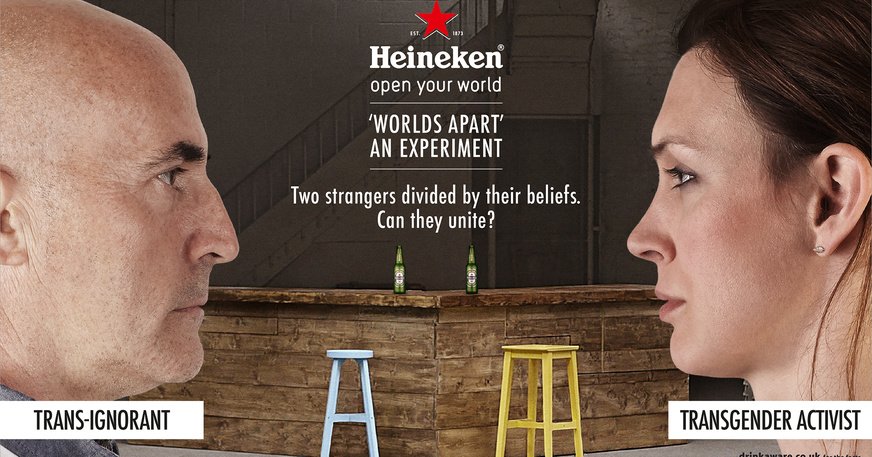Iconic Ads: Heineken – Worlds Apart

The goal of Heineken was to convince people to stop focusing on their differences and start focusing on what brings them together.
Over the three years prior to 2016, Heineken’s UK sales increased healthily. But the beer industry was facing some serious difficulties.
Still, Heineken only had a 2.5% market share in the premium lager market due to the resurgence of other brands. Peroni’s had a 5.1% market share while Stella’s had 12.1%.
There was a trend of “premiumization” of beer. Young adults concerned about their health had been a driving force behind this shift to a “quality over quantity” mentality. This move benefited the rapidly expanding craft industry at the expense of lagers.
The Importance of Communicating
Heineken wanted to reach out to millennials because they represented the largest potential market for volume expansion. Yet, there were several options for the typical lager consumer to consider.
The research demonstrated that Heineken needed to make a deeper emotional connection with prospective consumers in order to win their preference.
The UEFA Champions League, F1, and James Bond were all assets that Heineken has sponsored in the past. Although they are excellent tools for establishing a premium, global image for the company, they were not the best choices for establishing a strong foundation in the local market.
In addition, studies revealed that the intended audience had difficulty understanding the meaning of the phrase “Open Your World.” Just 14% said Heineken made them more open-minded.
This presented both a problem and an opportunity for communications to fill in the blanks and give the brand more depth.
Heineken, critically, would not be engaged in the meaning-making industry. “Open Your World” originated from the core beliefs of the Heineken brand. With distribution in 192 countries, Heineken was the most international beer in the world. The idea that you can only really grow by venturing outside your comfort zone is fundamental to the brand. They only needed their intended audience to grasp it.
Scenario
In 2016, when Britain was at its most politically polarised, the campaign was conceived.
The month of June saw a 41% increase in hate crimes and the Brexit vote. Throughout the course of the year, the gap between the wealthy and everyone else widened.
Now more than ever was the time to give “Open Your World” its full intended meaning.
After the referendum, many individuals were taken aback. Yet Brexit was really only a symptom of a larger problem.
Research revealed that free speech has been stifled. Individuals avoided engaging with people who disagreed with them. The rise of “echo chambers” on social media may be to blame. Their algorithms amplified people’s predisposition towards confirmation bias, or the inclination to give more weight to viewpoints that already matched their own.
Publicis, the advertising agency, was inspired to start reflecting on this.
Although many believe they have an open mind, they seldom go beyond their own “echo chambers” to hear what the opposing side says. None of us are as forthright as we want to believe we are.
Finding a Middle Ground
Although “echo chambers” may have made it simple to generalize about unknown individuals, such behaviour goes against human nature. We’re hardwired to look for points of connection with the other humans we encounter.
The lesson learned was that individuals are not as hospitable as they seem, but a shared interest in beer may help break through barriers. Despite our differences, there is always something that may bring us together, and we have more in common than we do not. Edelman supported Heineken’s viewpoint with research from Goldsmiths University showing that sharing interests makes individuals more receptive to new ideas.
The first step in identifying shared interests is a simple chat. What better way to do it than with a cold one? It’s a great icebreaker and conversation starter. Everyone loosens up a little in the presence of alcoholic beverages.
The plan was straightforward: to use the reputation as a symbol of transparency to help bring together individuals who otherwise couldn’t speak to one another.
The “Worlds Apart” sociological experiment was the source of inspiration. David Monk, Christina Boccassini, Dom Desmond, Mark Daw, Seb Howling, and Rudhraigh McGrath made up the team of creators. The plan was to gather people of different political beliefs together for a Heineken and video them agreeing on something.
It was a fine balancing act to find suitable participants for this investigation. Publicis desired controversial pairings, but doing so may have damaged the company’s reputation.
Heineken’s corporate reputation management team and PR agency Edelman worked closely together to resolve the issue. They came to an understanding that they would present individuals with strong opinions without taking a stance on whether or not those opinions were correct.
Publicis took this approach after beginning their hunt. The casting director looked to internet networks like Facebook groups to find individuals with strong opinions. The casting process took three months, and they ultimately decided on nine different couples to shoot over the course of three days.
Once each couple had spent 90 minutes together, they would share their differences of opinion.
The Advertising
Just three of the nine possible couples were included in the final cut, and they were a trans woman and a transphobic guy, a radical feminist and a patriarchal male, and a steadfast environmentalist and a climate change sceptic.
Publicis realized they required a feature-length “hero” film to convey the tale in the most engaging and original manner possible. Yet, this made little sense at a time when people’s attention spans were becoming shorter and shorter. In order to get the most possible exposure for the long-form film, they analyzed the most popular videos from Facebook and YouTube and used that data to create a set of mobile-first guidelines.
They understood they had to forego the typical narrative structure of a television commercial in favour of something more akin to a teaser trailer for a film. They did this by drawing immediate attention to the conflicting viewpoints of the study’s participants. Then they saw they couldn’t just build to one climax but instead required a series of peaks. These resulted from the options presented to the attendees, which included staying to have a beverage and talk about the issues at hand or leaving.
Various Stages of Communication
In the initial stage, the focus was on raising general interest. The video served as an introduction to the discussion of the experiment and its results with Dr Chris Brauer of Goldsmith University. The Open Your World manifesto, outlining Heineken’s goals, was printed on the bottles and packaging.
In the next phase, Heineken and the Human Library worked together. Through discussion, they want to dispel preconceived notions. These are real individuals who have had exceptional lives, so you may borrow a “book,” chat with them for half an hour, and learn from their experiences. You can learn a lot more about individuals and have deeper conversations with them if you don’t prejudge them.
Outcome
- The campaign was extensive and interesting because:
There were a total of 50.5 million views of the films (including the hero cut and trailers), with 14.8 million of those views coming without any promotion.
On YouTube, just 2.3% of the 13.8 million total views resulted in revenue. Earned views increased by more than 83% (11.5 million). The majority of people who searched out the video remained to view the whole four minutes and fifty-five seconds of it, giving us an average organic completion percentage of 65%.
- National news organizations from the UK and other countries covered it.
After being picked up by Fast Company, the story went on to be covered by a wide variety of media outlets, including Upworthy, Mail Online, and many more. The analysis showed that 91% of respondents had a good impression.
Many celebs chimed in without being asked to do so.
Eventually, media outlets in the United States began covering the film, including CNN, Good Morning America, and USA Today.
Other Heineken markets took notice of the media hysteria. What started as a campaign limited to the United Kingdom quickly gained international traction when Heineken markets in the United States, Australia, Germany, Brazil, and many more agreed to back the British video with advertising dollars.
It was now obvious that the advertising had been successful, but what message was it sending about Heineken?
- The intended message was conveyed
According to diagnostics, a lot of the message got through. Those who remembered viewing the ad were much more likely to agree (78%) that Heineken is a brand that stands for openness and (80%) that it brings people together compared to those who did not remember seeing the ad.
- It added depth to the phrase ‘Open Your World.’
Considering the brand’s maturity and the campaign’s short duration, Heineken anticipated a muted response. Despite this, the campaign had an immediate and substantial impact on the most important brand KPIs.
The percentage of individuals who believe Heineken “stands for something substantial” rose by 26% at the campaign’s low point. Brand-wise and in terms of media efficiency, “Worlds Apart” ranks well within a database of 40 Heineken ads.
- That resulted in higher sales compared to the competitors.
Off-trade volume sales rose 11.9% during the campaign period, compared to the same time the previous year. That’s almost three times the increase of the overall lager category (3.9%) and nearly double the growth (3.6%) of premium lagers
Reference
https://www.contagious.com/news-and-views/insight-strategy-worlds-apart
https://www.campaignlive.com/article/heineken-publicis-built-brand-success-big-issues/1485709



